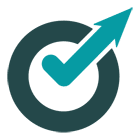Opinions expressed in this article are those of the sponsor. MarTech neither confirms nor disputes any of the conclusions presented below.
3 ways to take back control from PPC automations
When Google and the engines automate PPC tasks, you can still remain in control with "automation layering."
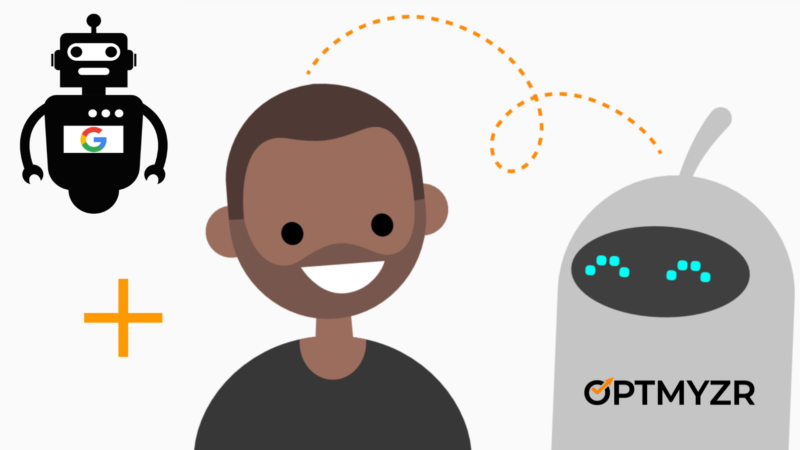
“Machines are better than people!”
While true in some instances, such a provocative statement conjures B-movie imagery of machines running rampant and destroying humanity — foretelling a time in which great intentions actually destroy the future.
Not the case in PPC. It’s true that, in certain functions, machines ARE better than people. The brilliant minds at Google, Bing, Amazon and Facebook are in a pitched battle to drive time-saving automations to ease the burden on PPC pros. So much so, that many people in our industry understandably fear being automated into a totally different career.
Reality? The more the big engines automate, the more value a smart PPC pro can bring to the game. Over the past year, we’ve made automation standard in our platform and integrated it more closely with automations from Google so that advertisers can do two things more efficiently:
- Advertisers can create their own automations using rules. Think of it as a simpler way to achieve what you may previously have tried doing with scripts.
- PPC experts can take back control as the engines introduce more automation using “automation layering“. Think of it as setting your own boundaries that the engine’s automations have to stay within. E.g. better control of automated bids, close variants, budgets, etc.
People often challenge us with understandable questions: “If Google has automated everything, why do I need a third party like Optmyzr?” That’s rational. However, Google and the others are automating the very things that should be automated. Repetitive, task-oriented activities that take up far too much of a PPC pro’s time and energy. What they haven’t automated is setting goals, picking strategies, making course corrections, and the many other things humans are good at.
What we all tend to agree on at face value is that humans + machines are always better than machines alone. But do we really mean we want more manual work to oversee the machines? Of course not! What we really want is some oversight over the algorithms built by the likes of Google and Microsoft.
This oversight could be done manually by advertisers, but that’s time-consuming. A better solution is for advertisers to create their own automations that monitor the automations of the engines. That’s what we call “automation layering.”
But most marketers can’t write code, so how can they build their own systems that automate working with the engines’ algorithms? At Optmyzr we provide a framework for advertisers to create their own scripts, alerts, and rules without writing a single line of code. Here are some examples of how our award-winning PPC tools can help you get started with automation layering for your ads account. We’ve put each of these examples in the context of the 3 future roles of PPC experts as explained in our book as well as several blog posts on this site.
1. Monitor correct implementation of your PPC strategy
PPC pros can think of themselves as the doctors of PPC and the automations created by Google as the medicine. It’s the doctor’s role to find out what ails the patient and what course of treatment might make them better. Likewise in PPC, the human expert understands the goal of the advertiser and chooses tools and automations that are most likely to help achieve the desired outcome.
Picking the right tools isn’t always as simple as it sounds. For example, advertisers may decide to test automated bidding, also called “Smart Bidding” by Google. But they may forget to take care of some of the recommended prerequisites like upgrading to a more sophisticated attribution model.
If an advertiser automates their bids with an unsophisticated attribution model like last-click attribution, the results are likely going to be sub-par. We’ve explained that in detail, but the crux of it is that the automations from the engines really aren’t all that smart and are meant to do one specific thing very well.
Case in point, automated bidding is not smart about attribution models and an advertiser using last-click attribution will see important keywords that are typically part of the earlier stages of the consumer journey getting bids that are too low. As a result, overall sales may decline after automating bids.
A good doctor understands the journey towards healing and the different treatments along the way. PPC doctors, too, must know when to use each of the tools from the engines and how to layer their automations for maximum impact.
Optmyzr helps PPC experts be good PPC doctors by offering a way to stay on top of what tools and settings are in use across many campaigns, or even many accounts. The PPC Policy and Audit tool is used to specify how an account should be set up and then automatically monitors for deviations from what is expected.
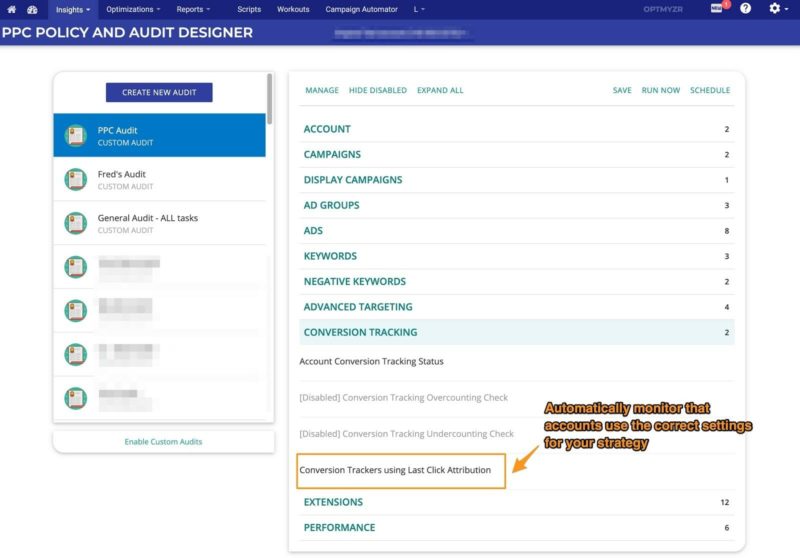

2. Monitor the automations from the engines
Once all the right tools and automations have been put into place, the PPC expert’s role shifts to that of a pilot who needs to monitor that the systems are working correctly and things are staying on course.
The PPC professional, too, needs to monitor their automations because as good as automated bidding may be at the math of predicting conversions, it’s horrible at flagging unexpected things. So automated bidding will likely do a good job of reducing CPCs when it notices a drop in conversion rate, but it won’t do anything to notify the advertiser that there is an anomaly in conversion rate or suggest what may be the root cause of the anomaly.
Optmyzr helps with monitoring by providing tools that can be layered on top of the PPC engine’s automations. Some examples include the anomaly detection script, a root cause analysis in the PPC Investigator, and fully customizable rules in the Rule Engine.
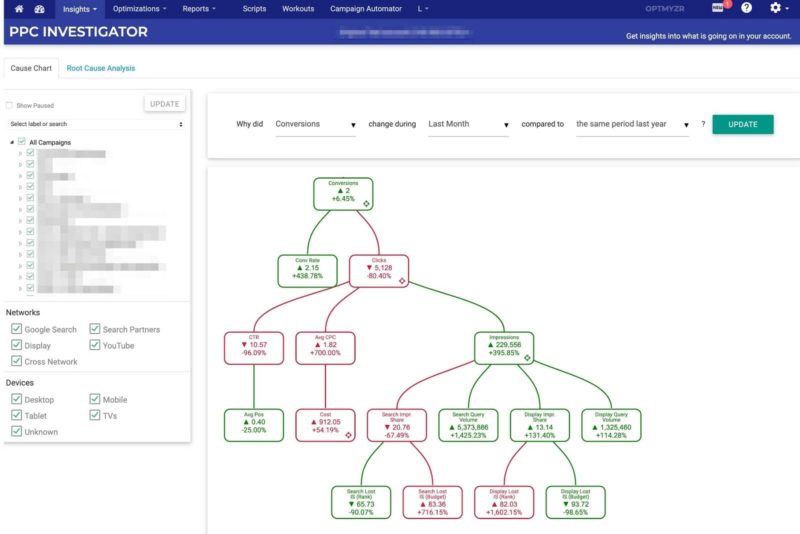
Automation layering is a critical concept for all PPC experts because there are changes to how Google Ads works every month and the easiest way to check if these changes are producing good results is to add an automated monitor from a 3rd party to check this.
The expansion of close variants to also encompass words with the same meaning comes to mind as a good recent example of where advertisers may want to deploy a tool to monitor the machine learning system from Google that determines what close variants are. By layering your own automation on top of that from Google, you can benefit from all the advances made by Google while resting easy that you’ll know when it’s not working as expected.
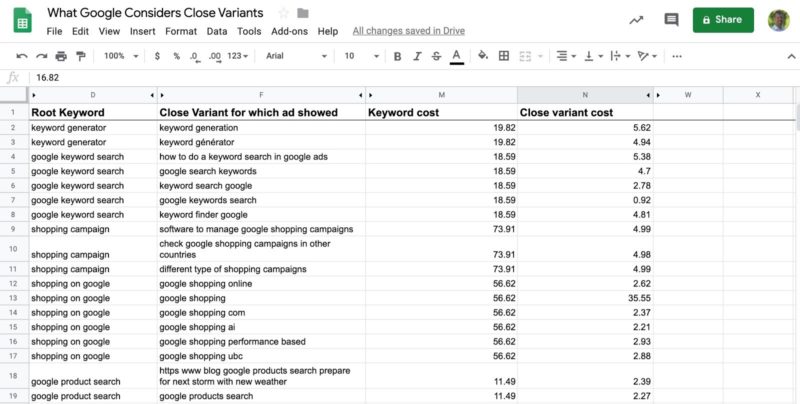
3. Teach the engines how to use your business data better
The third role humans will play in a PPC world where automations are everywhere is that of a teacher. Remember that many automations are driven by advances in machine learning and, as we all know, teachers are needed for learning.
So PPC experts need to use their own tools and automations to layer on top of what the engines are doing.
A cliche but easy-to-grasp example is that of bidding by weather. If you run a ski resort, you may have historical ski-lift sales data about how many lift passes you sell when the weather is sunny versus when it is snowing. Chances are that Google may not be taking this data into account when its automations decide which users to show ads to and how much to bid. So it would make perfect sense that the advertiser should help the Google system deliver better results by teaching it to do something different based on the weather.
Advertisers can and should still use smart bidding from Google, which is really good at determining patterns when users are in different locations, using certain types of devices, etc., but they can take control by varying the targets that these automated systems work with.
In a simple example, if an advertiser expects conversion rates will be double what they normally are, they can set a target CPA that is twice as high or a target ROAS that is half. These advertisers are NOT changing their target, but rather adjusting the part of the equation they can control to achieve the same targets as usual. So when conversion rate doubles and bids were higher thanks to an increased CPA target, the effective CPA will remain the same as always, but the advertiser will have gotten more conversions thanks to a higher position on the page.
Optmyzr’s Rule Engine can be used in a variety of ways to monitor and improve automations from Google and recently we explained how it can be used with external data, like weather, to add a layer of intelligence on top of Google’s automated bidding to help advertisers set themselves apart from their competition.


The bottom line on why you need automation layering
Automation layering provides a powerful path forward as PPC pros navigate an AI- and machine learning-infused world. Rather than making PPC pros obsolete, automation can redefine PPC pros as doctor, pilot, AND teacher — all in one.
- The PPC doctor taps technology to monitor, diagnose, and prescribe treatment of campaign problems.
- The PPC pilot stays on top of emerging issues and opportunities to guide programs to a successful conclusion — smoothing out bumps and addressing unexpected problems while in flight.
- The PPC teacher feeds information and data back into the machines to help them “learn” and drive more automations and machine-driven advancements. It’s the human being who crafts and understands objectives, knows the statistical modeling needed, and teaches the machines to be stronger and more effective.
The vast majority of automations at the platform level are really there to free up the PPC pro to continually migrate from the tactical to the strategic. While they save time with particular actions, they actually create a greater need for a centralized command center from which to manage programs, enact layered automations, and drive even greater outcomes. And these new tasks and processes that are part of modern PPC management can be automated and layered on top of the engine’s automations.
Optmyzr stands in that gap to turn PPC pros into PPC rockstars with better technology that saves time.
Related stories
